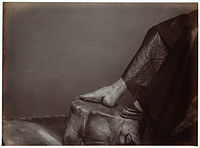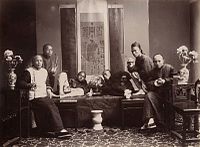Lai Afong
| Lai Afong | |
|---|---|
 | |
| Narození | 1839 Okres Kao-ming |
| Úmrtí | 19. dubna 1890 (ve věku 50–51 let) Hongkong |
| Povolání | fotograf a fotoreportér |
| Některá data mohou pocházet z datové položky. | |
Lai Afong (čínsky: 黎芳, asi 1839 – 19. dubna 1890)[1] byl čínský fotograf, který založil a provozoval Studio Afong, jedno z prvních fotografických studií v Hongkongu.[1] Je považován za jednoho z nejvýznamnějších čínských fotografů devatenáctého století.[2]
Životopis
Jeho studio bylo aktivní od roku 1859 do zhruba čtyřicátých let. Tento podnik pravděpodobně v 90. letech 19. století převzal jeho syn.[3] Témata se pohybovala od portrétů a obrázků společenského života až po městské veduty a krajiny. Laiovu výtvarnou práci a osobu ocenil John Thomson, skotský fotograf pracující v té době v Číně, ve své knize The Straits of Malacca, Indo-China, and China.[4] Laiova zkušenost pocházela zcela od západní společnosti, ale stále obsahovala vazbu na tradiční malbu starodávných mistrů a vnitřního ducha umělce.[5] Podle mnoha jeho fotografických vizitek, fotografoval mimo jiné guvernéra Arthura Kennedyho nebo velkovévodu Alexeje Romanova.
Jeho konkurent byl Liang Š'-tchaj, který provozoval své první fotografické studio v Hongkongu počátkem 70. let 19. století, jeho první reklama se objevila v hongkongském Daily Advertiser v říjnu 1871. V roce 1876 přestěhoval své studio do Šanghaje, pravděpodobně kvůli zvýšené konkurenci v Hongkongu.
Galerie
Tradiční svazování chodidel
Kuřáci opia
Chrám šesti fíkovníků
Panorama ostrova Ku-lang-jü a přístavního města Sia-men
Ulice s obchody v Kantonu
Čínský obr Čan Š'-čchaj měřil 2,6 metru
Studiový portrét
Čínští delikventi nosící dřevěný límec, 1870-1880
Čínský holič, 1870-1880
Skupina čínských žen s vějíři, Kanton, asi 1880
Tři kuliové, Hong Kong, asi 1880
Odkazy
Reference
V tomto článku byl použit překlad textu z článku Lai Afong na anglické Wikipedii.
- ↑ a b BENNETT, Terry. History of Photography in China: Chinese Photographers 1844-1879. Londýn: Bernard Quaritch, 2013. Dostupné v archivu pořízeném z originálu dne 28. 6. 2017. ISBN 9780956301246.
- ↑ HANNAVY, John. Encyclopedia of Nineteenth-Century Photography. [s.l.]: Routledge, 2013. Dostupné online. ISBN 9781135873264. S. 815.
- ↑ „Afong“ on Wattis Fine Art website
- ↑ THOMPSON, John. The Straits of Malacca, Indo-China, and China. [s.l.]: Harper & brothers, 1875. Dostupné online. S. 188–189.
- ↑ Meccarelli M. „New Perspectives about the Origins of Chinese Photography and Western Research in China“ in ARTE DAL MEDITERRANEO AL MAR DELLA CINA Genesi ed incontri di scuole e stili. Scritti in onore di Paola Mortari Vergara Caffarelli eds. P. Fedi – M. Paolillo, Officina di Studi Medievali, Palermo, 2015, str. 587–598
Související články
Externí odkazy
 Obrázky, zvuky či videa k tématu Lai Afong na Wikimedia Commons
Obrázky, zvuky či videa k tématu Lai Afong na Wikimedia Commons - BENNETT, Terry. History of Photography in China 1842-1860. [s.l.]: Bernard Quaritch, 2009. ISBN 978-0-9563012-0-8.
- BENNETT, Terry. History of Photography in China: Chinese Photographers 1844-1879. Londýn: Bernard Quaritch, 2013. Dostupné v archivu pořízeném z originálu dne 28. 6. 2017. ISBN 9780956301246.
- CHEN, Shi. Early Chinese Photographers from 1840 to 1870: Innovation and Adaptation in the Development of Chinese Photography. [s.l.]: University of Florida, 2009. Dostupné online.
- Brush & Shutter : early photography in China. Los Angeles, California: Getty Research Institute, 2011. Dostupné online. ISBN 978-1-60606-054-4.
Média použitá na této stránce
Only known Self-Portrait and autograph of Lai Afong
Chinese hairdresser
Photo taken from the bluff at the back of the former United States Consulate (26 Sanming Road) on Gulangyu Island (formerly Koolansoo Island), overlooking Xiamen island (formerly Amoy).
Autor: Lai Afong, Licence: CC BY 2.0
Entitled Group Of Chinese Women With Fans, Canton China [c1880] Afong Lai [RESTORED] I evened out the background, darkened the entire print, added contrast and a sepia.
Afong Lai was one of the rare breed of Chinese photographer whom was recognized by his European contemporaries as a professional equal. He was well thought of by the legendary John Thomson, who rated Afong's work of a caliber that would be successful even if offered to the English in London. As a Chinese working in what was then considered to be a strictly European field, Afong established and fostered contacts with many foreigners, allowing his work to be brought home by Europeans and thus to be seen abroad. For this reason, historic examples of his work survives to this day. He was active in and around the Guangdong area (then called Kwangtung), particularly in Hong Kong, where he ran one of the colony's longest working photographic studios, reportedly from 1859 through 1900.
Professionally, Afong Lai specialized in portraiture and landscapes, and was well known for his stitched panoramic views. Unfortunately, other than his technical and artistic achievements, little of his personal life was ever recorded. In fact, there is even question over his proper name; that is, was his surname Fong or Afong, or Ah Fong? I suspect that this arose from the lack of western linguistic appreciation for the Cantonese dialect. Cantonese speaking Chinese would immediately recognize the "Ah" preceding Fong as just a colloquialism (denoting intimacy or familiarity). This is similar to the "Lil" (a truncation of Little, in this case, used as a term of endearment or affection) that may precede a typical American name like Joe. However, most non Chinese observers of Fong's times did not intuitively understand this distinction, and mistakenly assumed his proper name to be Mister Ahfong. An English version of this mistake would be referring to someone as Mister Liljoe. Despite this mistake of not having his real name remembered, it nonetheless burnished Fong's undeniable place in history as one of the great photographers of late Qing China.
On Afong's stationary, it is clear that the printed name in English is AFONG. However, what is often lost to the English reader is the Chinese text, which reads Fong Wah, likely an amalgam of the proprietor's own name into the title of his business enterprise. In this case, that would mean that the owner's surname is simply Fong. The letter "A" (for "ah") placed in front of the surname Fong (a typical Cantonese surname), likely reflected the Chinese colloquial term of affection or endearment, but more importantly, also the title that Europeans normally knew Mr Fong as. Hence, Mr Fong probably kept that in his official English title as it was how he was best known to his foreign customers. Had Mr Fong been European say, with a name like Thomson, local Chinese may have then referred to him as Ah Thomson. It would have then been obvious that the colloquial "ah" was not a part of Thomson's name.























